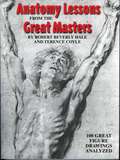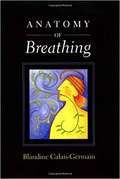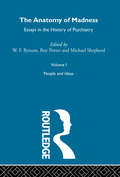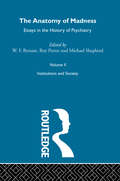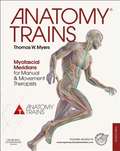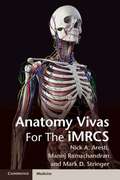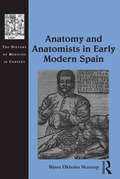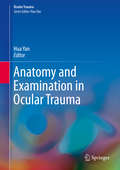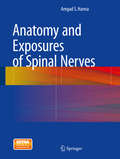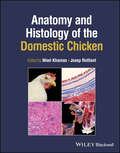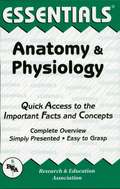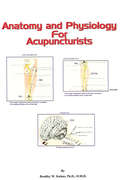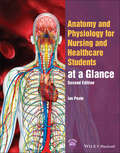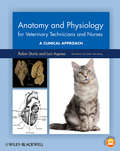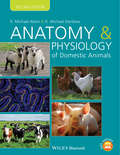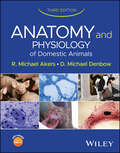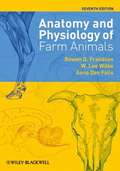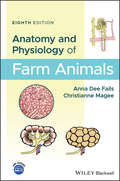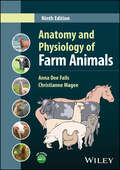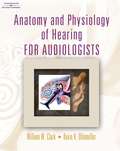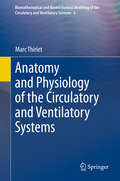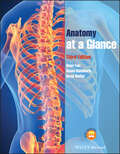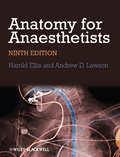- Table View
- List View
Anatomy Lessons from the Great Masters
by Robert Beverly Hale Terence CoyleThis classic book, whose foremost author was one of the great artistic anatomy teachers of the twentieth century, is an invaluable instructor and reference guide for any professional, amateur, or student artist who depicts the human form. Revealing the drawing principles behind one hundred inspiring masterpieces, the book presents work by Leonardo, Michelangelo, Rubens, Raphael, Titian, Rembrandt, and other greats.
Anatomy Of Breathing
by Blandine Calais-GermainMy hope is that [this book] will contribute to a more enlightened practice of breathing. I also hope that you, the reader, will have a better understanding of how breathing changes spontaneously from moment to moment. My other wish is that you will discover how to consciously choose a specific breathing technique for certain purposes or circumstances. -- Author s Preface Everyone breathes, yet few of us understand how to consciously control breathing to improve our well-being and the quality of many daily activities. Anatomy of Breathing is a clear and helpful guide to both the theory and practice of breathing in its many variations. Hundreds of expert drawings along with easy-to-understand text help you explore just how breathing works. Once you re acquainted with the principal organs, structures, and forces that affect breathing, you will learn how to control them to enhance the quality and variety of breathing in your own life. Along the way, you will also correct many common misconceptions about breathing. Anatomy of Breathing is filled with helpful practice pages. Here you will learn simple exercises to prepare your body for the benefits of different types of breathing. You will then be shown, step by step, how to practice some of the most common and useful breathing techniques on your own. Anatomy of Breathing is a unique and wonderful resource for anyone who wishes to understand the science and art of breathing, and how to make their own breathing better and more life-enhancing.
Anatomy Of Madness Vol 1: People And Ideas (Routledge Library Editions Ser.)
by Roy Porter Michael Shepherd W F BynumFirst Published in 2004. Routledge is an imprint of Taylor & Francis, an informa company.
Anatomy Of Madness Vol 2: People And Ideas (Routledge Library Editions Ser.)
by Roy Porter Michael Shepherd W F BynumFirst Published in 2004. Routledge is an imprint of Taylor & Francis, an informa company.
Anatomy Of Madness Vol 3: People And Ideas (Routledge Library Editions Ser.)
by Roy Porter Michael Shepherd W F BynumFirst Published in 2004. Routledge is an imprint of Taylor & Francis, an informa company.
Anatomy Trains: Myofascial Meridians For Manual And Movement Therapists
by Thomas MyersThe new edition of this hugely successful book continues to present a unique understanding of the role of fascia in healthy movement and postural distortion which is of vital importance to bodyworkers and movement therapists worldwide. Fully updated throughout and now with accompanying website (www.myersmyofascialmeridians.com), Anatomy Trains: Myofascial Meridians for Manual and Movement Therapists will be ideal for all those professionals who have an interest in human movement: massage therapists, structural integration practitioners, craniosacral therapists, yoga teachers, osteopaths, manual therapists, physiotherapists, athletic trainers, personal trainers, dance and movement teachers, chiropractors and acupuncturists.
Anatomy Vivas for the Intercollegiate MRCS
by Manoj Ramachandran Nick Aresti Mark StringerPresented in a question-and-answer format, Anatomy Vivas for the Intercollegiate MRCS will help candidates prepare for the anatomy section of the new Intercollegiate MRCS exam and will aid their learning in the format in which they will be tested. The book is unique in that it is based on the new examination. It is divided into the specialty areas and is based on clinical scenarios. Featuring photographs of dissections, detailed diagrams and radiographic images, the book is the most concise and accurate anatomy aid for the MRCS examination. Written by recent candidates, experienced surgical anatomists and authors of other successful MRCS guides, it features explanations presented in a memorable, logical and easy to learn manner, and highlights areas that regularly feature in the exam. Past questions, core topics and recurring themes are discussed in detail, ensuring that candidates are as prepared as possible. It is an indispensable guide to success.
Anatomy and Anatomists in Early Modern Spain (The History of Medicine in Context)
by Bjørn SkaarupTaking the Vesalian anatomical revolution as its point of departure, this volume charts the apparent rise and fall of anatomy studies within universities in sixteenth-century Spain, focussing particularly on primary sources from 1550 to 1600. In doing so, it both clarifies the Spanish contribution to the field of anatomy and disentangles the distorted political and historiographical viewpoints emerging from previous research. Studies of early modern Iberian science have only been carried out coherently and collaboratively in the last few decades, even though fierce debates on the subject have dominated Spanish historiography for more than two centuries. In the field of anatomy studies, many uninformed and biased readings of archival sources have resulted in a very confused picture of the practice of dissection and the teaching of anatomy in the Iberian Peninsula, in which the highly complex conditions of anatomical research within Spain’s national context are often oversimplified. The new empirical evidence that this book brings to light suggests a far more multifaceted narrative of Iberian Renaissance anatomy than has been presented to date.
Anatomy and Examination in Ocular Trauma (Ocular Trauma)
by Hua YanThis book aimed to provide the most thorough knowledge of ocular anatomy related to trauma and standard ocular examinations to clinical practitioners, such as the nurses, medical students, residents, fellows and even ophthalmologists, to help them making the most appropriate decision on the management of patients who have suffered from such ocular conditions. A thorough understanding of the anatomy of the eyeball and the traumatic characteristics of each structure of the eyeball are a prerequisite for proper interpretation of long-term outcomes of mechanical eye injuries.The first part provides the audiences general information of ocular anatomy, which will help them understand the basic anatomic knowledge and generate a clinical thinking. The following part provides the detailed examinations. They will help readers to make the right diagnose and offer the best advice or treatment to the patients. For each chapter, detailed clinical workup, clinical presentations and signs, and pictures or illustrative figures will be provided. Part 3 will benefit more medical coworkers to be familiar with the registration system of ocular trauma and its social and medical meaning. This will also help the advances of epidemiology and proper treatment approaches for ocular trauma. Hopefully this book may help the clinical practitioners to be fully prepared for any challenge of ocular traumatic cases.
Anatomy and Exposures of Spinal Nerves
by Amgad S. HannaThis book is a comprehensive illustrated surgical guide to operative exposures of the spinal nerves, also known as peripheral nerves. Each chapter is devoted to a particular nerve and describes the origin, anatomic relations, branches, surgical approaches, and clinical significance. The text is concise and easy to read and is complemented by informative color photos from cadaveric dissections and surgical procedures. A separate chapter on technical notes identifies surgical pearls relating to techniques such as nerve suturing and nerve transfers. Importantly, unlike other peripheral nerve atlases, this book is accompanied by videos of different approaches. The book will be especially valuable for residents and fellows in training and candidates for oral board and MOC examinations. It is also designed to provide a quick illustrated review for surgeons unfamiliar with a procedure. Most videos are less than 5 minutes long, and it should take less than 10 minutes to review each approach, including watching the video. Anatomy and Exposures of Spinal Nerves will effectively fill a gap caused by the absence of a peripheral nerve surgeon from many neurosurgery training programs.
Anatomy and Histology of the Domestic Chicken
by Wael Khamas Josep RutllantComprehensive reference describing in-depth physical anatomy and histology of domestic avian species chicken, depicted through high quality macro- and micro-photographs Atlas of Anatomy and Histology of the Domestic Chicken is a state-of-the-art atlas of avian anatomy that provides a complete collection of both original gross anatomy and histology photographs and texts of all body systems of the birds based on the domestic chicken to depict anatomic features. Using cutting-edge technology to create visualizations of anatomic structure, this specialist reference includes both gross anatomical structures/organs and their histological details next to each other. This approach enables readers to understand the macro- and micro-pictures of each organ/structure under study. The text includes a total of more than 200 high-resolution, high quality color images and diagrams. Written by two highly qualified professors with significant experience in the field, Anatomy and Histology of the Domestic Chicken includes information on: External features of the body, including regions, features, ornaments, shape, feathers, skin, and the uropygial gland Musculoskeletal characteristic including cartilage and bone formation and classification, flight and ambulatory muscles Digestive system, including the beak, esophagus, crop, proventriculus, ventriculus, intestines, and accessory glands Respiratory system, including external nares, the nasal cavity, trachea, upper larynx, syrinx, lungs, and air sacs Urinary system, including kidneys and the ureter, cloaca-urodeum, and genital system, covering differences between males and females Endocrine system, including pituitary, pineal, adrenal, pancreas, thyroid, and parathyroid glands Nervous system with central and peripheral divisions and sense organs including eye and ear Lymphatic system, with descriptions of the primary and secondary lymphatic organs Egg anatomy and development of the chick embryo Applied anatomical concepts important for clinical maneuvers and necropsy With comprehensive coverage of the subject and highly detailed photographs included throughout the text, Anatomy and Histology of the Domestic Chicken is an indispensable resource for breeders, veterinarians, researchers, avian biologists, pathologists, and students in animal sciences and veterinary fields.
Anatomy and Physiology Essentials (Essentials Study Guides)
by Jay M. TemplinREA's Essentials provide quick and easy access to critical information in a variety of different fields, ranging from the most basic to the most advanced. As its name implies, these concise, comprehensive study guides summarize the essentials of the field covered. Essentials are helpful when preparing for exams, doing homework and will remain a lasting reference source for students, teachers, and professionals. Anatomy and Physiology includes an introduction to the human body, the chemistry of life, cells, the skin, the skeletal system, the skeletal muscles, the nervous system, the sense organs, the endocrine system, the circulatory system, the respiratory system, the digestive system, the urinary system, the reproductive system, and human development.
Anatomy and Physiology For Acupuncturists (Made Easy)
by Bradley W. Kuhns, Ph.D., O.M.D.A book for acupuncturists, acupuncture students, chiropractors, physiologists, massage therapists, physical therapists, gym operators and bodybuilders and all of those interested in alternative health. Bradley W. Kuhns, Ph.D., O.M.D. is internationally recognized for his expertise and skills in the practice of acupuncture, oriental medicine and other related alternative medicine areas. He has used and shared his techniques both in private practice and as an adviser and consultant to many professionals, stars, entertainers and well known personalities around the world. Doctor Kuhns descibes in easy-to-read and understand terms -(Made Easy), important areas of anatomy, physiology and much, much more. For those of you who choose to use Dr. Kuhns techniques and information,in all likelihood, you will increase yuor health care skills to a much higher level.
Anatomy and Physiology for Nursing and Healthcare Students at a Glance (At a Glance (Nursing and Healthcare))
by Ian PeateAnatomy and Physiology for Nursing and Healthcare Students at a Glance The market-leading at a Glance series is popular among healthcare students and newly qualified practitioners for its concise, simple approach and excellent illustrations. Each bite-sized chapter is covered in a double-page spread with clear, easy-to-follow diagrams, supported by succinct explanatory text. Covering a wide range of topics, books in the at a Glance series are ideal as introductory texts for teaching, learning and revision, and are useful throughout university and beyond. Everything you need to know about anatomy and physiology … at a Glance! An ideal introduction and revision guide for anatomy and physiology As part of the popular At a Glance series, Anatomy & Physiology for Nursing & Healthcare Students provides a wonderful introduction to the topic and is written with the student nurse in mind. This is also a useful reference guide for any healthcare professional looking for a quick refresher on the human body. The book strikes a balance between being succinct without being superficial, with concise writing that provides an overview of anatomy and physiology. Helping nurses develop practical skills and deliver increasingly complex care for patients through the study of how the body functions, readers will also find: A user-friendly approach that includes bite-size pieces of information and full-colour diagrams to help students retain, recall, and apply facts to their practice Clinical practice points that aim to encourage readers to relate to the theoretical concepts in practice New to the second edition: a chapter on anatomical terms and emphasising the importance of the correct anatomical terminology in communication between healthcare professionals Includes access to a companion website with self-assessment questions for each chapter This quick and easy-to-digest introduction to anatomy and physiology is the perfect textbook for nursing students in all fields of practice, allied healthcare students including paramedics and physiotherapists, and newly qualified nurses and nursing associates. It is also an ideal reference book for anyone looking for an overview of the human body. The book is also available in a range of digital formats which allows for easy access on the go. For more information on the complete range of Wiley nursing and health publishing, please visit: www.wiley.com To receive automatic updates on Wiley books and journals, join our email list. Sign up today at www.wiley.com/email All content reviewed by students for students Wiley nursing books are designed exactly for their intended audience. All of our books are developed in collaboration with students. This means that our books are always published with you, the student, in mind. If you would like to be one of our student reviewers, go to www.reviewnursingbooks.com to find out more. This new edition is also available as an e-book. For more details, please see www.wiley.com/buy/9781119757207
Anatomy and Physiology for Veterinary Technicians and Nurses
by Lori Asprea Robin SturtzAnatomy and Physiology for Veterinary Technicians and Nurses: A Clinical Approach is a comprehensive resource on the anatomy and physiology of dogs and cats, with comparisons to horses, birds, and ruminants. Organized by body system with a comparative approach, the book follows a unique format by addressing anatomy separately from physiology for clarity and improved comprehension. Each anatomy chapter has a corresponding physiology chapter, complete with illustrations, charts, and boxes to promote understanding.Written specifically for veterinary technicians and nurses, the book applies anatomy and physiology to clinical practice, with case examples demonstrating clinical relevance. The figures from the book, additional questions and answers, labeling quizzes, teaching PowerPoints, and a dissection video are available online at www.wiley.com/go/sturtz. This introduction to body system analysis of normal structure and function is a must-have resource for students of veterinary technology and nursing, as well as a useful quick review for the busy professional.
Anatomy and Physiology for Veterinary Technicians and Nurses: A Clinical Approach
by Lori AspreaUpdated anatomy guide for veterinary practitioners and students with case studies, detailed dissection images, and review questions The Second Edition of Anatomy and Physiology for Veterinary Technicians and Nurses is a comprehensive guide to veterinary anatomy and physiology applicable to clinical practice, with case studies, detailed dissection images, review question, and supporting drawings, tables, and diagrams often overlooked in many comparable lab manuals available. This new edition consists of twenty-six chapters. It has been reorganized to provide a better flow of chapters and includes new chapters on special senses and sensory physiology as well as extended coverage of feline species. The book has also been updated with relevant diseases in each physiology chapter, more detailed and frequent images, more added online images, and additional study materials for students. In Anatomy and Physiology for Veterinary Technicians and Nurses, readers will find: Matching materials for the physiologic functions of the systems dissected, labeled, and observed to combine both didactic and psychomotor learning conceptsInformation on skeletal, joint, cardiovascular, respiratory, and muscle anatomy as well as the anatomy of the nervous, endocrine, digestive, reproductive, and urinary systemsDiscussion on cells and immunity, functions of common integument, osteology, physiology of joints and muscles, neurophysiology, and renal physiologyDetails pertaining to both mammal and non-mammal species such as aviansNew, detailed case studies and critical thinking questions The updated edition of Anatomy and Physiology for Veterinary Technicians and Nurses is an essential reference for veterinary technicians and nursing students seeking clear guidance on the subject.
Anatomy and Physiology of Domestic Animals
by D. Michael Denbow R. Michael AkersAnatomy and Physiology of Domestic Animals, Second Edition offers a detailed introduction to the foundations of anatomy and physiology in a wide range of domestic species. Well illustrated throughout, the book provides in-depth information on the guiding principles of this key area of study for animal science students, fostering a thorough understanding of the complex make-up of domestic animals. This Second Edition includes access to supplementary material online, including images and tables available for download in PowerPoint, a test bank of questions for instructors, and self-study questions for students at www.wiley.com/go/akers/anatomy.Taking a logical systems-based approach, this new edition is fully updated and now provides more practical information, with descriptions of anatomic or physiological events in pets or domestic animals to demonstrate everyday applications. Offering greater depth of information than other books in this area, Anatomy and Physiology of Domestic Animals is an invaluable textbook for animal science students and professionals in this area.
Anatomy and Physiology of Domestic Animals
by D. Michael Denbow R. Michael AkersComprehensive resource on the anatomy and physiology systems of common domestic animals, with learning resources included throughout Anatomy and Physiology of Domestic Animals bridges the gap between theory and practice, emphasizing real-world applications. In this newly revised and updated Third Edition, each chapter includes a short section which emphasizes current animal management practices that take advantage of physiological principles discussed in that chapter to improve animal growth, development, or function. Instructors will gain access to a website with PowerPoint slides of all of the figures, tables, and illustrations used in the book, with one PowerPoint presentation for each chapter. A test bank of potential questions for each book chapter is featured, including short answer, matching, true and false, and discussion questions. Each chapter also includes a study guide located at the end of each chapter and an opening section that provides an outline and listing of key concepts that the reader should get from each chapter. Some of the key revisions to this Third Edition of Anatomy and Physiology of Domestic Animals include: Genetic testing and modification of DNA to improve animal health or performance and the use of RNA to create vaccinesThe dynamic nature of skin, not just as physical protection, but also in its relevance in immunityThe role of supportive non-neurons and proteins in brain functionNew discoveries in hormone signaling and uses of hormone therapies in domestic animalsReproductive strategies to regulate estrus, breeding schemes, and sex of offspring Anatomy and Physiology of Domestic Animals is an essential up-to-date reference for undergraduate students in animal science, dairy science, pre-veterinary medicine, veterinary technician training, and biology. The book is also relevant as reference/review text for graduate students in animal sciences and physiology.
Anatomy and Physiology of Farm Animals
by Anna Dee Fails Rowen D. Frandson W. Lee WilkeThe Seventh Edition of Anatomy and Physiology of Farm Animals is a thoroughly updated and revised version of this classic text. Drawing on current science and terminology with a number of new illustrations throughout and a new chapter on poultry, the book maintains its reputation for clarity, balanced scope, and breadth of content. The Seventh Edition provides veterinary, animal science, agriculture, and veterinary technician students with a comprehensive yet clear reference to understanding the fundamentals of anatomy and physiology.
Anatomy and Physiology of Farm Animals
by Anna Dee Fails Christianne MageeRevised and updated, the eighth edition of Anatomy and Physiology of Farm Animals remains the essential resource for detailed information on farm animal anatomy and physiology. Offers a revised edition to this comprehensive guide to the anatomy and physiology of farm animals Presents learning objectives in each chapter for the first time Adds new material on endocrine and metabolic regulation of growth and body composition Features additional illustrations to enhance comprehension Includes a companion website that offers supplemental content, including word roots, clinical cases, study and practice questions, the images from the book and additional images, diagrams, and videos to enhance learning.
Anatomy and Physiology of Farm Animals
by Anna Dee Fails Christianne MageeA complete guide to the anatomy and physiology of farm animals, fully updated and revised In the newly revised ninth edition of Anatomy and Physiology of Farm Animals, distinguished veterinary professors Drs. Anna Fails and Christianne Magee deliver a comprehensive guide for animal science, veterinary technician, and pre-veterinary students and instructors seeking a well-organized and easy-to-understand resource. The new edition offers modified and refined learning objectives at the beginning of each chapter, as well as a brand-new chapter on llamas/alpacas that highlights the significant species differences and explains the roles of these species in the wool and packing industries. Additional illustrations enhance comprehension and improve the anatomy sections of the book. New “Study Prompts,” integrative application questions, are included in each chapter in differently colored text and stimulate understanding of the material. Finally, a reorganized companion website is included with the book. It integrates fully with the print text and provides supplemental content, including word roots, clinical cases, study and practice questions, and additional images, diagrams, and videos. Readers will also find: An excellent anatomy and physiology resource for high school and undergraduate students in animal science, veterinary medicine, and zoology programsComprehensive explorations of the anatomy and physiology of the cell Practical discussions of embryology, the skeletal system, and microscopic anatomy Complete discussion of the physiology of muscle and the anatomy and physiology of the nervous system A valuable comprehensive resource for advanced high school and undergraduate animal science students in agriculture, pre-veterinary, and veterinary technical program, Anatomy and Physiology of Farm Animals will also benefit people practicing in allied professions and veterinary practitioners.
Anatomy and Physiology of Hearing for Audiologists
by Kevin K. Ohlemiller William W. ClarkThe first anatomy and physiology text just for audiologists, this new text brings together some of the best professional minds in the field to consider the structures and mechanisms of the auditory system. <P><P>Basic science is covered in the foundations section of the text, giving a much needed examination of the biological processes in terms the audiologist needs most. <P><P>Detailed examination of the anatomy and physiology of hearing follows with diagrams and in-depth discussions. The text concludes with chapters on the pathology of hearing, covering the different causes of hearing loss, from noise-induced hearing loss to genetic aspects of hearing loss. <P><P>From start to finish this text is written specifically for the audiologist, making it an essential foundational resource.
Anatomy and Physiology of the Circulatory and Ventilatory Systems (Biomathematical and Biomechanical Modeling of the Circulatory and Ventilatory Systems #6)
by Marc ThirietTogether, the volumes in this series present all of the data needed at various length scales for a multidisciplinary approach to modeling and simulation of flows in the cardiovascular and ventilatory systems, especially multiscale modeling and coupled simulations. The cardiovascular and respiratory systems are tightly coupled, as their primary function is to supply oxygen to, and remove carbon dioxide from, the body's cells. Because physiological conduits have deformable and reactive walls, macroscopic flow behavior and prediction must be coupled to nano- and microscopic events in a corrector scheme of regulated mechanism. Therefore, investigation of flows of blood and air in physiological conduits requires an understanding of the biology, chemistry, and physics of these systems, together with the mathematical tools to describe their functioning in quantitative terms. The present volume focuses on macroscopic aspects of the cardiovascular and respiratory systems in normal conditions, i. e. , anatomy and physiology, as well as the acquisition and processing of medical images and physiological signals.
Anatomy at a Glance
by Simon Blackburn Omar Faiz David MoffatFollowing the familiar, easy-to-use at a Glance format, and in full-colour, this new edition provides an accessible introduction and revision aid for medical, nursing and all health sciences students. Thoroughly updated and now fully supported by a set of web-based flashcards, Anatomy at a Glance provides a user-friendly overview of anatomy to encapsulate all that the student needs to know. Anatomy at a Glance: Addresses the basic concepts of anatomy in an highly visual, easy-to-remember way Features two new chapters outlining anatomical terminology and basic embryology Includes more coverage of imaging techniques such as CT and MRI Offers free online flashcards for self-assessment and revision at www. wiley. com/go/anatomyataglance To find out more about the at a Glance series, please visit www. ataglanceseries. com
Anatomy for Anaesthetists
by Andrew Lawson Harold EllisFirst published in 1963, Anatomy for Anaesthesists is the definitive anatomy text for anaesthetists in training and remains an invaluable reference for those in practice. The text explores in depth those areas of particular interest to anaesthetists: the respiratory pathway, the heart, the vertebral canal and its contents, the peripheral nerves, the autonomic nervous system, and the cranial nerves, and also includes sections on the anatomy of pain and other zones of anaesthetic interest.This new 9th edition has been fully revised and updated to incorporate developments in regional techniques and the increased use of ultrasound.
